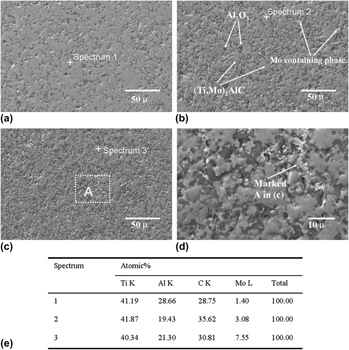Article contents
Effect of MoO3 addition on the microstructure and mechanical properties of Ti2A1C prepared by reactive hot pressing
Published online by Cambridge University Press: 27 August 2013
Abstract

Fully dense (Ti,Mo)2AlC/Al2O3 in situ composites with high purity were successfully synthesized at 1350 °C by reactive hot pressing of the Ti, Al, TiC, and MoO3 powder mixtures. The effect of MoO3 content on the phase composition, microstructure, and mechanical properties was investigated in detail. The introduction of the Al–MoO3 displacement reaction into the Ti–Al–TiC system resulted in a submicron grain size and a homogeneously distributed matrix phase of (Ti,Mo)2AlC with a secondary Al2O3 phase. The matrix grain size was significantly refined with increasing the Al2O3 content. Compared with the sample without MoO3 addition, the addition of 13.81 wt% MoO3 (corresponding to 10 wt% Al2O3 formation) evidently enhanced the hardness, flexural strength, and fracture toughness by 25%, 69%, and 146%, respectively. The strengthening and toughening mechanisms for the (Ti,Mo)2AlC/Al2O3 composites were also investigated.
- Type
- Articles
- Information
- Copyright
- Copyright © Materials Research Society 2013
References
REFERENCES
- 2
- Cited by


